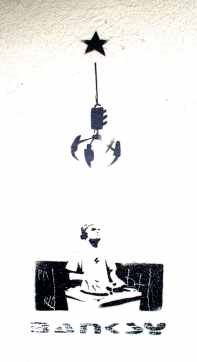professional interest
 As a longtime maker of mixtapes and related compliations, I will admit to being fascinating by how this is done professionally. So I really enjoyed this article in the New Yorker on 'audio branding' at Muzak (emph all mine)
As a longtime maker of mixtapes and related compliations, I will admit to being fascinating by how this is done professionally. So I really enjoyed this article in the New Yorker on 'audio branding' at Muzak (emph all mine)A business’s background music is like an aural pheromone. It attracts some customers and repels others, and it gives pedestrians walking past the front door an immediate clue about whether they belong inside. A chain like J. C. Penney, whose huge customer base includes all ages and income levels, needs a program that will make everyone feel welcome, so its soundtrack contains familiar and relatively unassertive popular songs like “Kind and Generous,” by Natalie Merchant. The Hard Rock Hotel in Orlando, which appeals to a more narrowly focussed audience, plays “Girls, Girls, Girls,” by Mötley Crüe, and cranks up the volume. (Imagine how teen-agers would perceive the jeans and t-shirts at Abercrombie & Fitch—not a Muzak client—if those stores played country-and-Western hits.) Audio architects have to keep all this in mind as they build their programs. They also have to be aware of certain broad truths about background music: bass solos are difficult to hear, extended electric-guitar solos annoy male sports-bar customers, drum solos annoy almost everyone, and Bob Dylan’s harmonica can make it hard for office workers to concentrate. Audio architects also have to screen lyrics carefully. They removed the INXS hit “Devil Inside” from many of the company’s playlists after a devout Christian complained, and they are ever vigilant for the word “funk,” which almost everyone mistakes for something elseLest you think its only about keeping dirty words from the ears of the devout, devotees of audio architecture (which is a phrase I love) seem inspired with their own fervent passion for all types of music more than eager to amp up the smooth jazz and dull the senses. Their digital collection
"includes seven hundred and seventy-five tracks recorded by the Beatles, a hundred and thirty by Kanye West, three hundred and twenty-four by Led Zeppelin, eighty-four by Gwen Stefani, a hundred and ninety-one by 50 Cent, and nine hundred and eighty-three by Miles Davis."The license every genre and bit of music they can find in order to supply some exacting customers, like: a French-owned chocolatier in New York City.
“They want the program to include music from everyplace in the world where cocoa grows,” McKelvey told me. “It’s a challenge, to say the least, but it’s fun.” Shortly before we talked, she had been listening to lounge and rhythmic music from Brazil and West Africa, and to a number of less exotic songs, including familiar jazz tunes that she felt conveyed a mood of chocolate-appropriate romance.Also the technical side is both growing more sophisticated and precise:
One of the techniques used at Muzak is dynamic range compression, which consists of turning down the loudest parts of a signal and then turning up the entire signal; it’s the reason that television commercials often seem louder than the programs they interrupt even though the commercials and the programs are technically limited to the same sound level. In addition, audio architects frequently use tracks as bridges between music from different eras—say, placing a Verve remix of a jazz standard between an Ella Fitzgerald classic and a recent release by Macy Gray. Tracks in the Well are catalogued not only by artist and title but also by producer, label, and date. Recordings from particular studios in particular eras often share a characteristic sound—like wines from particular vineyards and vintages—and some juxtapositions work better than others.But as always, the secret to a good compliation is in the syntax, not the phonology(to use a trivial linguistic metaphor):
Take Armani Exchange. Shoppers there are looking for clothes that are hip and chic and cool. They’re twenty-five to thirty-five years old, and they want something to wear to a party or a club, and as they shop they want to feel like they’re already there. So you make the store sound like the coolest bar in town. You think about that when you pick the songs, and you pay special attention to the sequencing, and then you cross-fade and beat-match and never break the momentum, because you want the program to sound like a d.j.’s mix.” She went on, “For Ann Taylor, you do something completely different. The Ann Taylor woman is conservative, not edgy, and she really couldn’t care less about segues. She wants everything bright and positive and optimistic and uplifting, so you avoid offensive themes and lyrics, and you think about Sting and Celine Dion, and you leave a tiny space between the songs or gradually fade out and fade in.”How soon before our iPods and other media devices will talk to the store and tell them what we like to listen to?
Español | Deutsche | Français | Italiano | Português| Ch| Jp| Ko







0 Comments: